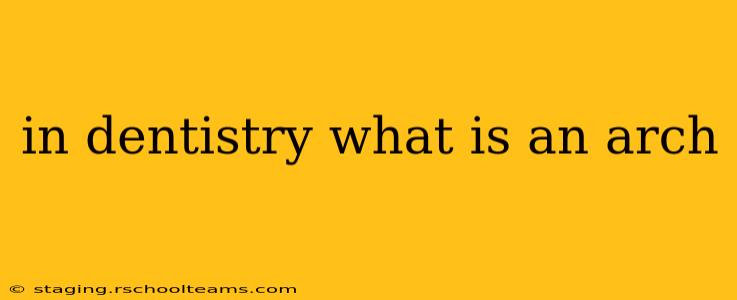Understanding Dental Arches: A Comprehensive Guide
In dentistry, an arch refers to the curved row of teeth in either the upper or lower jaw. Think of it as the overall shape and arrangement of your teeth in each jaw. We have two dental arches: the maxillary arch (upper arch) and the mandibular arch (lower arch). Understanding the anatomy and function of these arches is crucial for proper dental health and treatment.
What are the maxillary and mandibular arches?
The maxillary arch is the upper arch of teeth, fixed firmly to the maxilla (upper jaw bone). It's generally wider and more U-shaped than the mandibular arch. The mandibular arch is the lower arch of teeth, attached to the mandible (lower jaw bone). This arch is typically more V-shaped and narrower than the maxillary arch. The precise shape and size of each arch vary between individuals, influenced by genetics and developmental factors.
What is the significance of dental arches in dentistry?
The proper alignment and relationship between the maxillary and mandibular arches are fundamental to optimal oral function and aesthetics. Malocclusion, or misalignment of the teeth and jaws, can significantly impact:
- Chewing and biting: Proper arch alignment is essential for efficient chewing and biting. Misaligned teeth can interfere with the normal biting force and lead to difficulties in consuming food.
- Speech: The position of the teeth plays a role in the production of certain sounds. Malocclusion can affect articulation and speech clarity.
- Appearance: Straight, well-aligned teeth contribute significantly to a pleasing smile and overall facial aesthetics.
- Oral hygiene: Crowded or misaligned teeth can be difficult to clean effectively, increasing the risk of plaque buildup and gum disease.
How are dental arches diagnosed and treated?
Dentists assess dental arches through various methods, including:
- Visual examination: A thorough visual examination of the teeth and jaws allows the dentist to assess the overall alignment and relationships between the arches.
- Radiographic imaging: X-rays, such as panoramic radiographs or cephalograms, provide detailed images of the teeth, jaws, and surrounding structures, helping to identify underlying issues affecting arch alignment.
- Models and study casts: Impressions of the teeth are taken to create plaster models, offering a precise representation of the arches for diagnosis and treatment planning.
Treatment for arch-related issues can range from simple procedures like orthodontic appliances (braces) to more complex surgeries, depending on the severity of the malocclusion. Orthodontic treatment aims to correct the alignment of the teeth and jaws, improving both function and aesthetics.
What are some common problems related to dental arches?
Several issues can affect the alignment and health of the dental arches:
- Crowding: This occurs when there isn't enough space in the jaw to accommodate all the teeth, leading to overlapping or crooked teeth.
- Overbite: An excessive vertical overlap of the upper teeth over the lower teeth.
- Underbite: A condition where the lower teeth protrude beyond the upper teeth.
- Crossbite: A condition where the upper and lower teeth don't align properly, with some upper teeth biting inside the lower teeth or vice versa.
- Open bite: A gap between the upper and lower teeth when biting down.
These conditions can impact chewing, speech, and appearance, and often require orthodontic intervention for correction.
What is the relationship between dental arches and facial structure?
The dental arches are intricately linked to the overall facial structure. The shape and size of the arches influence facial proportions and symmetry. Malocclusion can sometimes lead to noticeable changes in facial features. Orthodontic treatment, therefore, can not only improve the alignment of teeth but also enhance facial aesthetics.
This comprehensive overview provides a solid understanding of dental arches, their significance, common issues, and treatment options. Remember to consult with your dentist for any concerns about the alignment or health of your dental arches. They can provide a personalized assessment and recommend the appropriate treatment plan.
